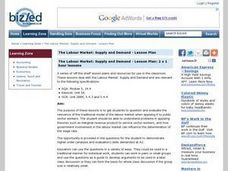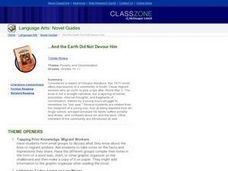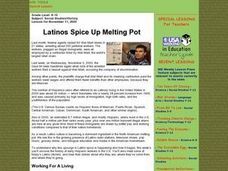ProCon
Minimum Wage
The first ever minimum wage in America was set at 25 cents per hour in 1938 and has been steadily, if slowly, increasing ever since. Using the provided website, pupils decide if the United States should further increase the federal...
Federal Reserve Bank
Would Increasing the Minimum Wage Reduce Poverty?
Here is a fantastic and relevant question to discuss with your class members. Using detailed reading material and a related instructional activity, your learners will learn about labor markets, equilibrium wages, price floors, and...
PBS
Organizing the Farm Worker Movement
The food on young scholars' tables was likely harvested by hands that fought for fair wages and working conditions. By examining the life of Cesar Chavez and Dolores Huerta, learners connect their daily meals with the struggles of those...
Smithsonian Institution
Strength in Solidarity: Coalition of Immokalee Workers and the Campaign for Fair Food
Not all food is created equal. The lesson plan dives into the world of migrant farm workers to show their struggles to earn livable wages and better working conditions. Academics learn why the Coalition of Immokalee Workers was created...
Curated OER
The Free Trade Conundrum: Balancing Worker Wages and Consumer Prices Comparing the 19th and 21st Centuries
By examining free trade, protectionism, and analyzing 19th and 21st century arguments for and against the tariff, learners will be able to compare and contrast the 19th and 21st century. They will analyze text, answer discussion...
Council for Economic Education
Wages and the Black Death
While the Black Death wiped out a third of Europe's population during the Middle Ages, its destruction paved the way for better wages for workers and even an early form of modern capitalism. The relationship between the cataclysmic event...
Curated OER
Waging A Living
High schoolers view a video clip about minimum wage. They discover the history of wage policy in the United States and the difference between the minimum wage and living wage. They write a paper on how to increase the wages.
California Department of Education
Safe at Work
From minimum wage to minimizing injuries, young workers need to know their rights! The sixth and final lesson in a series of college and career readiness activities gets eighth graders thinking about safety and labor laws.
Constitutional Rights Foundation
Automation and the American Worker
A thought-provoking resource examines the future of automation and the effects on employment. Academics read informational text, complete written prompts, and participate in activities to understand automation and the possibilities for...
Curated OER
The Economics of Risk
Students consider the plight of immigrant food industry workers in the United States. In this social justice lesson, students identify the pros and cons of being an undocumented worker in the U.S. and discuss labor laws.
Curated OER
The Free Trade Conundrum: Balancing Worker Wages and Consumer Prices Comparing the 19th and 21st Centuries
Exploring the concepts of free trade and protectionism, students compare and contrast 19th and 21st century arguments for and against the tariff.
Curated OER
What Does It Cost? Wages and Expenses in Historical Context
Students research the relative value of a historical dollar. They use old newspapers to find costs for food, housing, clothing, and transportation and then calculate the number of hours a worker would need to be employed to live...
Curated OER
The Labour Market: Supply and Demand
Students question and evaluate the relevance of the traditional model of the labour market and apply it to public sector workers. They investigate problem problems and apply theories such as marginal revenue product to service sector...
Curated OER
Jobs
Students review newspaper want ads and note information about wages and salaries. They identify the jobs, wages, salaries and fringe benefits from the ads. Students explain why people work for others and the importance of wages,...
Curated OER
Inequalities in the Workforce
Fourth graders examine careers that differ in the amount of wages paid to women and men. They interview their parents and discover they are contributing to society. They discover their role within the community as well.
Curated OER
...And the Earth Did Not Devour Him
Students examine impressions of a community of migrant workers in Texas who go north to pick crops. The instructional activity highlights the poverty and discrimination that a family suffers in the 1970's.
Curated OER
Development of Labor Unions
Students examine the conditions that led to organized labor unions. In this 20th century America lesson, students compare and contrast the Knights of Labor Constitution, the American Federation of Labor Constitution, and the Industrial...
The New York Times
A Worker's Compensation
Middle schoolers read about the history of Labor Day in a newspaper article. They discuss difficulties American employees of the past had to face, learn about labor rallies, and conduct Internet research. Part of the intention of this...
Museum of Tolerance
Why is This True?
Are wages based on race? On gender? Class members research wages for workers according to race and gender, create graphs and charts of their data, and compute differences by percentages. They then share their findings with adults and...
Curated OER
Vital Work
Students consider the role of women in the food industry. In this gender exploitation instructional activity, students work in groups to examine unfair labor practices. Students watch a video and write a fictional letter from a female...
Curated OER
Farmworkers and the Union: A Lesson from Viva La Causa
Young scholars examine the role of labor unions. In this labor union lesson plan, students watch "Viva la Causa" and discuss the working conditions that led farm workers to strike. Young scholars also read a handout regarding labor...
Curated OER
Latinos Spice Up Melting Pot
Students investigate the history of early Hispanic workers in the U.S. They complete an online Webquest, explore various websites, read about Latinos in the U.S. today, view a mural, and answer discussion questions.
Curated OER
Thinking About the World of Work
Pupils explore the laws and protections afforded to adolescent workers. They analyze two case studies, create KWL charts, participate in class discussions and write entries in a thinking log to record their reflections.
National First Ladies' Library
Workers, Take a Holiday! the Beginning of Labor Day
When your upper elementary class returns in the fall, have them identify and define the beginnings of the labor movement and Labor Day in the United States. They thoughtfully reflect on changes that have occurred in the way we think...

























